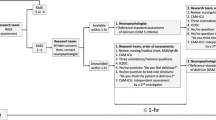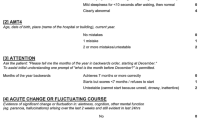Abstract
Hepatic encephalopathy (HE), a subtype of delirium, is common in cirrhosis and associated with poor outcomes. Yet, objective bedside screening tools for HE are lacking. We examined the relationship between an established screening tool for delirium, Confusion Assessment Method for the Intensive Care Unit (CAM-ICU) and short-term outcomes while comparing its performance with previously established measures of cognitive function such as West Haven criteria (WHC). Prospectively enrolled adults with cirrhosis who completed the CAM-ICU from 6/2014–6/2018 were followed for 90 days. Blinded provider-assigned West Haven Criteria (WHC) and other measures of cognitive function were collected. Logistic regression was used to test associations between CAM-ICU status and outcomes. Mortality prediction by CAM-ICU status was assessed using Area under the Receiver Operating Characteristics curves (AUROC). Of 469 participants, 11% were CAM-ICU( +), 55% were male and 94% were White. Most patients were Childs-Pugh class C (59%). CAM-ICU had excellent agreement with WHC (Kappa = 0.79). CAM-ICU( +) participants had similar demographic features to those CAM-ICU(-), but had higher MELD (25 vs. 19, p < 0.0001), were more often admitted to the ICU (28% vs. 7%, p < 0.0001), and were more likely to be admitted for HE and infection. CAM-ICU( +) participants had higher mortality (inpatient:37% vs. 3%, 30-day:51% vs. 11%, 90-day:63% vs. 23%, p < 0.001). CAM-ICU status predicted mortality with AUROC of 0.85, 0.82 and 0.77 for inpatient, 30-day and 90-day mortality, respectively. CAM-ICU easily screens for delirium/HE, has excellent agreement with WHC, and identifies a hospitalized cirrhosis cohort with high short-term mortality.



Similar content being viewed by others
Data availability
The datasets generated during and/or analysed during the current study are available from the corresponding author on reasonable request.
References
American Psychiatric Association (2013) Diagnostic and statistical manual of mental disorders: DSM-5. DSM-5 Task Force. Arlington, VA, American Psychiatric Association
Amodio P (2018) Hepatic encephalopathy: Diagnosis and management. Liver Int 38(6):966–975. https://doi.org/10.1111/liv.13752
Amodio P, Del Piccolo F, Marchetti P, Angeli P, Iemmolo R, Caregaro L, Merkel C, Gerunda G, Gatta A (1999) Clinical features and survivial of cirrhotic patients with subclinical cognitive alterations detected by the number connection test and computerized psychometric tests. Hepatology 29(6):1662–1667. https://doi.org/10.1002/hep.510290619
Bajaj JS, O’Leary JG, Tandon P, Wong F, Kamath PS, Biggins SW, Garcia-Tsao G, Lai J, Fallon MB, Thuluvath PJ, Vargas HE, Maliakkal B, Subramanian RM, Thacker LR, Reddy KR (2019) Targets to improve quality of care for patients with hepatic encephalopathy: data from a multi-centre cohort. Aliment Pharmacol Ther 49(12):1518–1527. https://doi.org/10.1111/apt.15265
Bajaj JS, Riggio O, Allampati S, Prakash R, Gioia S, Onori E, Piazza N, Noble NA, White MB, Mullen KD (2013) Cognitive dysfunction is associated with poor socioeconomic status in patients with cirrhosis: an international multicenter study. Clin Gastroenterol Hepatol 11(11):1511–1516. https://doi.org/10.1016/j.cgh.2013.05.010
Boehm L, Pun BT, Stollings J (2016) CAM-ICU Training Manual. Avaiable at https://www.icudelirium.org/resource-downloads/cam-icu-training-manual.
Camus V, Burtin B, Simeone I, Schwed P, Gonthier R, Dubos G (2000) Factor analysis supports the evidence of existing hyperactive and hypoactive subtypes of delirium. Int J Geriatr Psychiatry 15(4):313–316. https://doi.org/10.1002/(sici)1099-1166(200004)15:4%3c313::aid-gps115%3e3.0.co;2-m
Cordoba J (2011) New assessment of hepatic encephalopathy. J Hepatol 54(5):1030–1040. https://doi.org/10.1016/j.jhep.2010.11.015
Deksnytė A, Aranauskas R, Budrys V, Kasiulevičius V, Sapoka V (2012) Delirium: its historical evolution and current interpretation. Eur J Intern Med 23(6):483–486. https://doi.org/10.1016/j.ejim.2012.06.010
Desai AP, Reau, N (2016) The Burden of Rehospitalization for Patients With Liver Cirrhosis. Hosp Pract (1995) 44(1):60–69 https://doi.org/10.1080/21548331.2016.1142828
Ely EW, Inouye SK, Bernard GR, Gordon S, Francis J, May L, Truman B, Speroff T, Gautam S, Margolin R, Hart RP, Dittus R (2001) Delirium in mechanically ventilated patients: validity and reliability of the confusion assessment method for the intensive care unit (CAM-ICU). JAMA 286(21):2703–2710. https://doi.org/10.1001/jama.286.21.2703
Ely EW, Shintani A, Truman B, Speroff T, Gordon SM, Harrell FE, Inouye SK, Bernard GR, Dittus RS (2004) Delirium as a predictor of mortality in mechanically ventilated patients in the intensive care unit. JAMA 291(14):1753–1762. https://doi.org/10.1001/jama.291.14.1753
Ferenci P, Lockwood A, Mullen K, Tarter R, Weissenborn K, Blei AT (2002) Hepatic encephalopathy–definition, nomenclature, diagnosis, and quantification: final report of the working party at the 11th World Congresses of Gastroenterology, Vienna, 1998. Hepatology 35(3):716–721. https://doi.org/10.1053/jhep.2002.31250
Guenther U, Popp J, Koecher L, Muders T, Wrigge H, Ely EW, Putensen C (2010) Validity and reliability of the CAM-ICU Flowsheet to diagnose delirium in surgical ICU patients. J Crit Care 25(1):144–151. https://doi.org/10.1016/j.jcrc.2009.08.005
Gusmao-Flores D, Salluh JI, Chalhub RA, Quarantini LC (2012) The confusion assessment method for the intensive care unit (CAM-ICU) and intensive care delirium screening checklist (ICDSC) for the diagnosis of delirium: a systematic review and meta-analysis of clinical studies. Crit Care 16(4):R115. https://doi.org/10.1186/cc11407
Hu C, Anjur V, Saboo K, Reddy KR, O’Leary J, Tandon P, Wong F, Garcia-Tsao G, Kamath PS, Lai JC, Biggins SW, Fallon MB, Thuluvath P, Subramanian RM, Maliakkal B, Vargas H, Thacker LR, Iyer RK, Bajaj JS (2021) Low Predictability of Readmissions and Death Using Machine Learning in Cirrhosis. Am J Gastroenterol 116(2):336–346. https://doi.org/10.14309/ajg.0000000000000971
Jones, R. N., F. M. Yang, Y. Zhang, D. K. Kiely, E. R. Marcantonio and S. K. Inouye (2006). Does educational attainment contribute to risk for delirium? A potential role for cognitive reserve. J Gerontol Ser A Biol Sci Med Sci 61(12):1307–1311 https://doi.org/10.1093/gerona/61.12.1307
Khan BA, Perkins AJ, Gao S, Hui SL, Campbell NL, Farber MO, Chlan LL, Boustani MA (2017) The Confusion Assessment Method for the ICU-7 Delirium Severity Scale: A Novel Delirium Severity Instrument for Use in the ICU. Crit Care Med 45(5):851–857. https://doi.org/10.1097/CCM.0000000000002368
Koola JD, Ho SB, Cao A, Chen G, Perkins AM, Davis SE, Matheny ME (2020) Predicting 30-Day Hospital Readmission Risk in a National Cohort of Patients with Cirrhosis. Dig Dis Sci 65(4):1003–1031. https://doi.org/10.1007/s10620-019-05826-w
LaHue SC, Douglas VC, Kuo T, Conell CA, Liu VX, Josephson SA, Angel C, Brooks KB (2019) Association between Inpatient Delirium and Hospital Readmission in Patients >/= 65 Years of Age: A Retrospective Cohort Study. J Hosp Med 14(4):201–206. https://doi.org/10.12788/jhm.3130
Maldonado JR (2017) Acute Brain Failure: Pathophysiology, Diagnosis, Management, and Sequelae of Delirium. Crit Care Clin 33(3):461–519. https://doi.org/10.1016/j.ccc.2017.03.013
Orman ES, Ghabril MS, Desai AP, Nephew L, Patidar KR, Gao S, Xu C, Chalasani N (2021) Patient-Reported Outcome Measures Modestly Enhance Prediction of Readmission in Patients with Cirrhosis. Clin Gastroenterol Hepatol. https://doi.org/10.1016/j.cgh.2021.07.032
Orman ES, Perkins A, Ghabril M, Khan BA, Chalasani N, Boustani MA (2015) The confusion assessment method for the intensive care unit in patients with cirrhosis. Metab Brain Dis 30(4):1063–1071. https://doi.org/10.1007/s11011-015-9679-8
Ortiz M, Cordoba J, Doval E, Jacas C, Pujadas F, Esteban R, Guardia J (2007) Development of a clinical hepatic encephalopathy staging scale. Aliment Pharmacol Ther 26(6):859–867. https://doi.org/10.1111/j.1365-2036.2007.03394.x
Patel RP, Gambrell M, Speroff T, Scott TA, Pun BT, Okahashi J, Strength C, Pandharipande P, Girard TD, Burgess H, Dittus RS, Bernard GR, Ely EW (2009) Delirium and sedation in the intensive care unit: survey of behaviors and attitudes of 1384 healthcare professionals. Crit Care Med 37(3):825–832. https://doi.org/10.1097/CCM.0b013e31819b8608
Patidar KR, Thacker LR, Wade JB, Sterling RK, Sanyal AJ, Siddiqui MS, Matherly SC, Stravitz RT, Puri P, Luketic VA, Fuchs M, White MB, Noble NA, Unser AB, Gilles H, Heuman DM, Bajaj JS (2014) Covert hepatic encephalopathy is independently associated with poor survival and increased risk of hospitalization. Am J Gastroenterol 109(11):1757–1763. https://doi.org/10.1038/ajg.2014.264
Prakash R, Mullen KD (2010) Mechanisms, diagnosis and management of hepatic encephalopathy. Nat Rev Gastroenterol Hepatol 7(9):515–525. https://doi.org/10.1038/nrgastro.2010.116
Rosenberg R, Renvillard SG, Hjerrild S (2013) Organic delirious states and other psychiatric disorders: lessons for the hepatologists. Metab Brain Dis 28(2):235–238. https://doi.org/10.1007/s11011-012-9340-8
Salam M, Matherly S, Farooq IS, Stravitz RT, Sterling RK, Sanyal AJ, Gibson DP, Wade JB, Thacker LR, Heuman DM, Fuchs M, Puri P, Luketic V, Bickston SJ, Bajaj JS (2012) Modified-orientation log to assess hepatic encephalopathy. Aliment Pharmacol Ther 35(8):913–920. https://doi.org/10.1111/j.1365-2036.2012.05038.x
Sessler CN, Gosnell MS, Grap MJ, Brophy GM, O’Neal PV, Keane KA, Tesoro EP, Elswick RK (2002) The Richmond Agitation-Sedation Scale: validity and reliability in adult intensive care unit patients. Am J Respir Crit Care Med 166(10):1338–1344. https://doi.org/10.1164/rccm.2107138
Stepanova M, Mishra A, Venkatesan C, Younossi ZM (2012) In-hospital mortality and economic burden associated with hepatic encephalopathy in the United States from 2005 to 2009. Clin Gastroenterol Hepatol 10(9):1034–1041 e1031 https://doi.org/10.1016/j.cgh.2012.05.016
Tapper EB, Finkelstein D, Mittleman MA, Piatkowski G, Chang M, Lai M (2016) A Quality Improvement Initiative Reduces 30-Day Rate of Readmission for Patients With Cirrhosis. Clin Gastroenterol Hepatol 14(5):753–759. https://doi.org/10.1016/j.cgh.2015.08.041
Tapper EB, Henderson JB, Parikh ND, Ioannou GN, Lok AS (2019) Incidence of and Risk Factors for Hepatic Encephalopathy in a Population-Based Cohort of Americans With Cirrhosis. Hepatol Commun 3(11):1510–1519. https://doi.org/10.1002/hep4.1425
Truman B, Ely EW (2003) Monitoring delirium in critically ill patients. Using the confusion assessment method for the intensive care unit. Crit Care Nurs 23(2):25–36; quiz 37–28
Vilstrup H, Amodio P, Bajaj J, Cordoba J, Ferenci P, Mullen KD, Weissenborn K, Wong P (2014) Hepatic encephalopathy in chronic liver disease: 2014 Practice Guideline by the American Association for the Study of Liver Diseases and the European Association for the Study of the Liver. Hepatology 60(2):715–735. https://doi.org/10.1002/hep.27210
Wong CL, Holroyd-Leduc J, Simel DL, Straus SE (2010) Does this patient have delirium?: value of bedside instruments. JAMA 304(7):779–786. https://doi.org/10.1001/jama.2010.1182
Funding
APD is funded by National Institute of Diabetes and Digestive and Kidney Diseases of the National Institutes of Health under award number K23DK123408. ESO is funded by National Institute of Diabetes and Digestive and Kidney Diseases of the National Institutes of Health under award number K23DK109202. The funder was not involved in the design and conduct of the study; collection, management, analysis, and interpretation of the data; preparation, review, or approval of the manuscript; or decision to submit the manuscript for publication.
Author information
Authors and Affiliations
Contributions
Study Concept and Design: Archita Desai, MD; Eric S. Orman, MD, MS.
Data Analysis: Devika Gandhi, MD; Chenjia Xu, PhD; Archita Desai, MD; Eric S. Orman, MD, MS.
Manuscript Preparation: Devika Gandhi, MD; Archita Desai, MD.
Critical Manuscript Review: All authors.
Corresponding author
Ethics declarations
Competing interests
The authors declare that they have no conflict of interests which are directly relevant to this work. For full disclosure, relationships unrelated to this work are listed. Dr. Naga Chalasani served as a paid consultant to Abbvie, Madrigal, Zydus, Galectin, Boehringer-Ingelheim, Lilly, and Altimmune. He has research funding from NIH, Galectin, DSM, and Exact Sciences. Dr. Chalasani has equity in RestUp, Inc, a start-up specializing in health care staff placement. Dr. Boustani receives consulting fees and honoria from Lilly, Eisa, BioGen, Genetech, ACADIA, Merck. Additionally, he has patents pending for the “ABC Took Kit” and Agile Processes and has stock options in PPHM, RestUP and BlueAgillis.Ethics approval: This study was performed in line with the principles of the Declaration of Helsinki. Approval was granted by the Indiana University Institutional Review Board. (Last Date of Approval July 20, 2022/No 1402496491).
Consent to participate
Informed consent was obtained from all individual participants included in the study.
Consent to publish
The authors affirm that human research participants provided informed consent for publication of their data.
Additional information
Publisher's note
Springer Nature remains neutral with regard to jurisdictional claims in published maps and institutional affiliations.
Supplementary Information
Below is the link to the electronic supplementary material.
Rights and permissions
Springer Nature or its licensor (e.g. a society or other partner) holds exclusive rights to this article under a publishing agreement with the author(s) or other rightsholder(s); author self-archiving of the accepted manuscript version of this article is solely governed by the terms of such publishing agreement and applicable law.
About this article
Cite this article
Desai, A.P., Gandhi, D., Xu, C. et al. Confusion assessment method accurately screens for hepatic encephalopathy and predicts short-term mortality in hospitalized patients with cirrhosis. Metab Brain Dis 38, 1749–1758 (2023). https://doi.org/10.1007/s11011-022-01149-4
Received:
Accepted:
Published:
Issue Date:
DOI: https://doi.org/10.1007/s11011-022-01149-4




